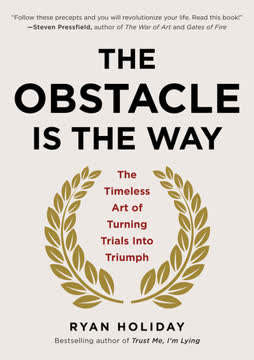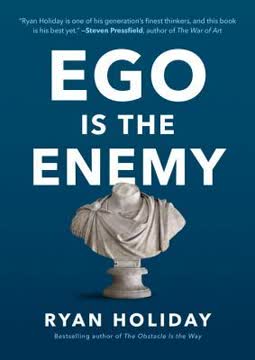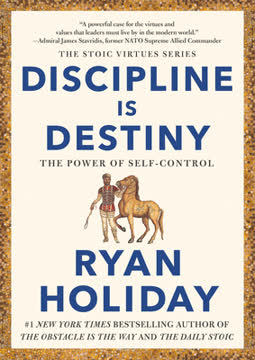Key Takeaways
1. Stoicism: A practical philosophy for resilience and virtue
"The only reason to study philosophy is to become a better person."
Philosophy as a way of life. Stoicism, founded in Greece in the 3rd century BC, emphasizes the cultivation of virtue and personal character as the path to a fulfilling life. Unlike abstract philosophical debates, Stoicism focuses on practical wisdom applicable to everyday challenges.
The four cardinal virtues. Stoicism is built on four key virtues:
- Courage: Facing life's challenges with bravery
- Justice: Treating others fairly and ethically
- Temperance: Exercising self-control and moderation
- Wisdom: Pursuing knowledge and sound judgment
These virtues serve as a compass for navigating life's complexities, guiding Stoics towards ethical decision-making and personal growth.
2. Zeno's shipwreck: The birth of Stoicism from adversity
"I made a prosperous voyage when I suffered shipwreck."
Turning misfortune into opportunity. Zeno of Citium, the founder of Stoicism, lost his entire fortune in a shipwreck. Instead of despairing, he saw this catastrophe as a chance for personal transformation, leading him to study philosophy in Athens.
Key Stoic principles:
- Focusing on what's within our control
- Accepting external events with equanimity
- Finding opportunity in adversity
- Cultivating virtue as the highest good
Zeno's response to his misfortune exemplifies the Stoic approach to life's challenges, demonstrating how even the most difficult circumstances can be reframed as opportunities for growth and self-improvement.
3. Cleanthes: The power of perseverance and hard work
"Better to trip with the feet than with the tongue."
Humble origins, profound impact. Cleanthes, successor to Zeno, embodied Stoic principles through his tireless work ethic. Despite poverty, he supported his philosophical studies by working as a water-carrier at night, earning the nickname "the Well-Water-Drawer."
Cleanthes' life demonstrates key Stoic virtues:
- Perseverance in the face of hardship
- Dedication to self-improvement
- Humility and indifference to social status
- Integrity in words and actions
His famous "Hymn to Zeus" poetically expresses Stoic cosmology and ethics, highlighting the interconnectedness of all things and the importance of aligning oneself with nature's rational order.
4. Chrysippus: The logical foundation of Stoicism
"If there had been no Chrysippus, there would be no Stoa."
The systematizer of Stoicism. Chrysippus, often called the "Second Founder" of Stoicism, was crucial in developing the school's logical framework. His prolific writing and sharp intellect helped defend Stoicism against rival philosophies and internal challenges.
Chrysippus' contributions:
- Formalized Stoic logic and epistemology
- Developed the concept of "cosmic sympathy" (interconnectedness of all things)
- Refined ethical theories, including the idea of "preferred indifferents"
- Emphasized the importance of reason in controlling emotions
His work provided a robust intellectual foundation for Stoicism, allowing it to withstand centuries of scrutiny and remain relevant to this day.
5. Stoicism enters politics: From Athens to Rome
"The duty of a man is to be useful to his fellow-men; if possible, to be useful to many of them."
Philosophy meets pragmatism. As Stoicism spread from Greece to Rome, it evolved from a purely theoretical pursuit to a practical guide for political and social engagement. Figures like Panaetius and Posidonius adapted Stoic principles to address the complexities of Roman life and governance.
Key developments:
- Emphasis on civic duty and social responsibility
- Integration of Stoic ethics with Roman values
- Application of Stoic principles to statecraft and leadership
- Influence on Roman law and social reforms
This transition marked a crucial phase in Stoicism's evolution, as it became a philosophy not just for contemplation, but for active participation in shaping society and government.
6. Cato and Seneca: Contrasting approaches to power
"I begin to speak only when I'm certain what I'll say isn't better left unsaid."
Integrity vs. compromise. Cato the Younger and Seneca represent two different approaches to applying Stoic principles in political life. Cato was known for his unwavering integrity and resistance to corruption, while Seneca sought to influence power from within, often compromising his ideals.
Comparing their approaches:
- Cato: Uncompromising adherence to principle, even at personal cost
- Seneca: Pragmatic engagement with power, attempting to guide from within
Both figures highlight the challenges of maintaining Stoic virtue in the face of political realities, and their stories continue to provoke debate about the best way to effect change in complex systems.
7. Epictetus: Freedom in the face of slavery
"He is a wise man who does not grieve for the things which he has not, but rejoices for those which he has."
Inner freedom transcends circumstances. Born a slave, Epictetus became one of Stoicism's most influential teachers. His life and teachings demonstrate that true freedom comes from within, regardless of external circumstances.
Epictetus' key teachings:
- Focus on what's within our control (thoughts, judgments, actions)
- Accept what's beyond our control with equanimity
- Understand the difference between appearance and reality
- Practice self-discipline and cultivate virtuous habits
His "Handbook" (Enchiridion) remains a concise and powerful guide to Stoic practice, influencing countless individuals across centuries, from emperors to modern CEOs.
8. Marcus Aurelius: The philosopher king's inner dialogue
"You have power over your mind - not outside events. Realize this, and you will find strength."
Leadership through self-reflection. Marcus Aurelius, Roman Emperor from 161 to 180 AD, embodied the Stoic ideal of the philosopher-king. His personal journal, known as "Meditations," offers intimate insights into how Stoic principles can be applied to the challenges of leadership and daily life.
Key themes in "Meditations":
- Constant self-examination and ethical reflection
- Accepting change and impermanence
- Focusing on duty and service to others
- Maintaining perspective on fame, power, and material possessions
Marcus Aurelius' writings demonstrate how Stoic practices can provide resilience and clarity, even for those bearing the weight of immense responsibility.
9. The Stoic approach to adversity and death
"Death smiles at us all; all we can do is smile back."
Embracing mortality for better living. Stoicism teaches that confronting our mortality and life's inevitable challenges can lead to a more meaningful and virtuous existence. By accepting what we cannot change, we free ourselves to focus on what we can improve.
Stoic strategies for facing adversity:
- Negative visualization: Imagining worst-case scenarios to appreciate what we have
- Voluntary discomfort: Practicing hardship to build resilience
- View from above: Gaining perspective by considering our place in the cosmos
- Memento mori: Remembering death to prioritize what truly matters
These practices aim to cultivate emotional resilience and clarity of purpose, enabling Stoics to face life's difficulties with courage and equanimity.
10. Stoicism's enduring legacy and modern relevance
"Waste no more time arguing about what a good man should be. Be one."
Ancient wisdom for modern challenges. Stoicism's practical approach to ethics and personal growth has found renewed relevance in the modern world. Its teachings on resilience, self-control, and focusing on what's within our power resonate with people facing the complexities of contemporary life.
Modern applications of Stoicism:
- Cognitive Behavioral Therapy draws on Stoic ideas
- Business leaders apply Stoic principles to decision-making and leadership
- Military personnel use Stoic practices for mental toughness
- Individuals adopt Stoic exercises for personal development and stress management
The enduring appeal of Stoicism lies in its timeless insights into human nature and its practical tools for living a meaningful, ethical life in the face of uncertainty and adversity.
Last updated:
FAQ
What's Lives of the Stoics about?
- Exploration of Stoic Philosophy: Lives of the Stoics by Ryan Holiday and Stephen Hanselman explores the lives of key Stoic philosophers from Zeno to Marcus Aurelius, illustrating how they applied Stoic principles in their lives.
- Biographical Focus: Each chapter provides a biography of a Stoic figure, highlighting their contributions to Stoicism and the lessons we can learn from their experiences.
- Historical Context: The book also provides a historical backdrop, showing how Stoicism evolved from its origins in Athens to its prominence in the Roman Empire.
Why should I read Lives of the Stoics?
- Practical Wisdom: The book offers accessible wisdom that can be applied to modern life, making Stoic philosophy relevant today.
- Inspiring Stories: It presents engaging narratives of resilience, integrity, and moral courage, motivating readers to face adversity with Stoic principles.
- Comprehensive Overview: It serves as an excellent introduction to Stoicism for newcomers and a valuable resource for seasoned readers.
What are the key takeaways of Lives of the Stoics?
- Philosophy as Action: The book emphasizes that philosophy should lead to becoming a better person, aligning with Seneca's view that it should result in a happy life.
- Four Virtues of Stoicism: Courage, temperance, justice, and wisdom are highlighted as guiding principles for living a good life.
- Learning from Lives and Deaths: The Stoics teach us how to live and face death with dignity, emphasizing the importance of character and legacy.
What are the best quotes from Lives of the Stoics and what do they mean?
- “The only reason to study philosophy is to become a better person.”: This quote encapsulates the book's theme that philosophy should improve one's character and life.
- “Well-being is realized by small steps, but is truly no small thing.”: Reflects the Stoic belief that personal growth is achieved through consistent, small actions.
- “It is better to starve to death in a calm and confident state of mind than to live anxiously amidst abundance.”: Emphasizes the significance of inner peace over material wealth.
Who are some of the key Stoic figures discussed in Lives of the Stoics?
- Zeno of Citium: The founder of Stoicism, Zeno's teachings emphasized living in accordance with nature and virtue.
- Marcus Aurelius: Known as the philosopher king, his writings reflect his commitment to Stoic principles amidst leadership challenges.
- Epictetus: A former slave turned philosopher, he taught that true freedom comes from within, focusing on self-control and what is within our control.
How does Lives of the Stoics relate to modern life?
- Relevance of Stoic Principles: The book illustrates how Stoic teachings can help navigate modern challenges like stress and uncertainty.
- Focus on Character Development: Encourages prioritizing character and virtue over material gains, offering tools for resilience and emotional regulation.
- Practical Applications: Provides examples of applying philosophical principles in everyday situations, making it easier to integrate these lessons into life.
What specific method or advice does Lives of the Stoics offer?
- Turning Philosophy into Action: Encourages readers to reflect on personal choices and strive to embody Stoic virtues in their lives.
- Embracing Adversity: Teaches that adversity can be a catalyst for growth, encouraging viewing challenges as opportunities for learning.
- Living with Purpose: Advocates for living in accordance with nature and virtue, fostering a sense of duty and connection to others.
What is the significance of the four virtues in Lives of the Stoics?
- Foundation of Stoic Ethics: Courage, temperance, justice, and wisdom are central to Stoic ethics, guiding moral decision-making.
- Interconnectedness of Virtues: Emphasizes that these virtues are inseparable and must be cultivated together for a harmonious life.
- Practical Guidance: Each virtue offers guidance for facing life's challenges, such as courage for confronting fears and temperance for moderation.
How do the lives of the Stoics teach us about facing death?
- Acceptance of Mortality: Stoics believed understanding mortality is essential for living well, teaching that death should not be feared.
- Living with Purpose: Contemplating death encourages focusing on what truly matters—virtue, relationships, and meaningful actions.
- Dignity in Death: Illustrates how Stoics faced death with dignity, inspiring readers to cultivate acceptance and courage.
What lessons can be drawn from the failures of the Stoics in Lives of the Stoics?
- Human Imperfection: Highlights that even great philosophers are not immune to failure, serving as cautionary tales about compromising principles.
- Importance of Integrity: Reminds us that integrity is paramount, encouraging steadfastness in values to avoid lasting consequences.
- Learning from Mistakes: Encourages self-reflection and growth, learning from mistakes to strive for continuous improvement.
What is the significance of the Stoic concept of apatheia in Lives of the Stoics?
- Definition of apatheia: Refers to a state of being free from destructive emotions, representing emotional resilience and clarity of thought.
- Emotional Control: Achieving apatheia allows individuals to respond to challenges with reason rather than emotion.
- Path to Virtue: Seen as essential for living a virtuous life, aligning actions with values through emotional control.
What role does sympatheia play in Stoic philosophy as discussed in Lives of the Stoics?
- Definition of sympatheia: Refers to the interconnectedness of all humans, emphasizing community and mutual support.
- Moral Responsibility: Highlights a moral obligation to act for the common good, as seen in the lives of philosophers like Marcus Aurelius.
- Empathy and Compassion: Encourages cultivating empathy and compassion, vital for harmonious relationships and a just society.
Review Summary
Lives of the Stoics receives mixed reviews, with some praising its accessible introduction to Stoic philosophers and their principles, while others criticize its lack of depth and historical accuracy. Many readers appreciate the biographical approach and find inspiration in the Stoics' lives, but some feel the book oversimplifies complex ideas. Critics argue it relies too heavily on speculation and modern interpretations. Despite these criticisms, fans of Ryan Holiday's work generally enjoy the book's storytelling and practical applications of Stoic philosophy.
Similar Books










Download PDF
Download EPUB
.epub digital book format is ideal for reading ebooks on phones, tablets, and e-readers.













